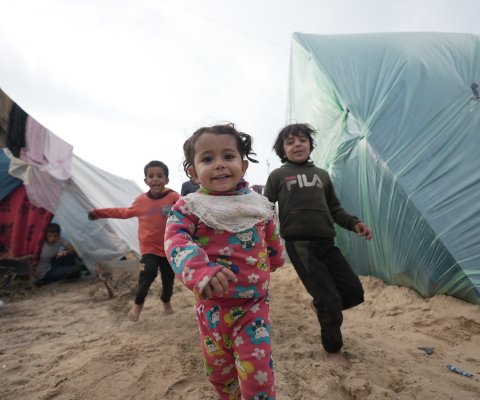
Tamara (left), 74, lives in a shelter for displaced persons in Mykolaiv oblast. Tetiana Kutas (right) is a project manager at The Tenth of April, a local organization who accompany families until they are settled in the shelter, helping them with papers and transport. Photo: Kieran Doherty/Oxfam
After eight years of armed conflict in the east of the country, the Russian Federation started a military offensive in Ukraine on 24 February 2022. The impact of this war has been devastating. It has so far caused more than 27,000 civilian casualties and the destruction of key infrastructure, such as hospitals, schools, homes, and water installations.
The conflict has displaced about 14 million people from their homes to seek safety within or outside the country, mostly to countries in Europe. Of those fleeing, 90% have been women, children and elderly people. While some refugees stay in neighbouring countries, many have passed through and travelled on to other destinations in Europe. Some have also returned to Ukraine. It is estimated that more than 3.5 million people are currently displaced within the country.
Our concerns for the most vulnerable
As a humanitarian organisation, Oxfam is gravely concerned about the impacts of the crisis on those most at risk – among both those who have fled the country and those who remain in Ukraine.
Many people who leave their homes are traumatized by war, separation, and travel. They can face difficulties in registering in other countries or regions, challenges accessing legal advice, and language barriers. Without the protections of their usual homes, sources of income, family and community, they are at greater risk of trafficking, extortion, and gender-based violence.
We are also concerned about the unequal treatment and lack of adequate protection of refugees from certain minority groups like the Roma, LGBTQIA+ communities, people from third countries outside the EU and Ukraine, young women and children travelling alone, and survivors of gender-based violence.

Adapting to an evolving crisis through partnerships
As the war in Ukraine continues on, communities affected by the crisis are having to constantly adapt to new realities. By working with local partners, Oxfam is able to adapt to the evolving situation and needs of communities affected by the war.
Oxfam’s humanitarian response: partnering with local civil society organizations
Together with partners, we have reached over 2 million people in 2 years.
Oxfam is responding to this humanitarian crisis by primarily working with local civil society organizations who are already supporting communities impacted by the war.In both Ukraine and in neighbouring countries we have supported 40 organizations.
Our partners have been able to expand their operations to deliver emergency life-saving assistance and protection across different areas: water and sanitation, shelter, food, cash distribution, legal assistance, information and counselling (particularly on the risks of human trafficking and gender-based violence), and mental health and psychological support, as well as a variety of integration services (such as language classes or job search support).
So far, we have helped more than 2 million people with vital humanitarian assistance.

TWO YEARS AT THE FOREFRONT: Exploring the needs and experiences of women-led, women's rights, and LGBTQIA+ led organizations two years into the Ukraine humanitarian response.
Two year on from the escalation of the war in Ukraine, we sat down with people from some of these organisations, who have been at the forefront of helping the people who need it most, to ask them about their experiences, needs and challenges.
As the war continues, a more structured support is needed
Oxfam will continue to coordinate with and support local partners to mitigate the devastating effects of the conflict. We are striving to ensure that we create and maintain equitable partnerships, adapting our ways of working and remaining flexible to best support local organizations based on their needs.
Donors and international humanitarian agencies need prioritize support and funding to local and national organizations in their response to the conflict in Ukraine, in particularly those supporting marginalised communities. These efforts must be centered on reforming the humanitarian system to put local leadership at the forefront of crisis response, both in Ukraine and around the world.

A Path Forward for Local Humanitarian Leadership in Ukraine
Over two and a half years into the war, the continued fighting has created extremely challenging conditions for civilians, particularly in the East of Ukraine.
Ukrainian communities and civil society have always been and continue to be at the forefront of responding to the humanitarian needs within their communities.

'My life is divided into before and after'
Three years since the invasion of Ukraine, the war continues to exact a toll on the lives of civilians and, on a devastating level, critical civilian infrastructure. As the conflict continues, uncertainty about Ukrainians' future deepens, and life for civilians is filled with navigating the impacts of the war.
